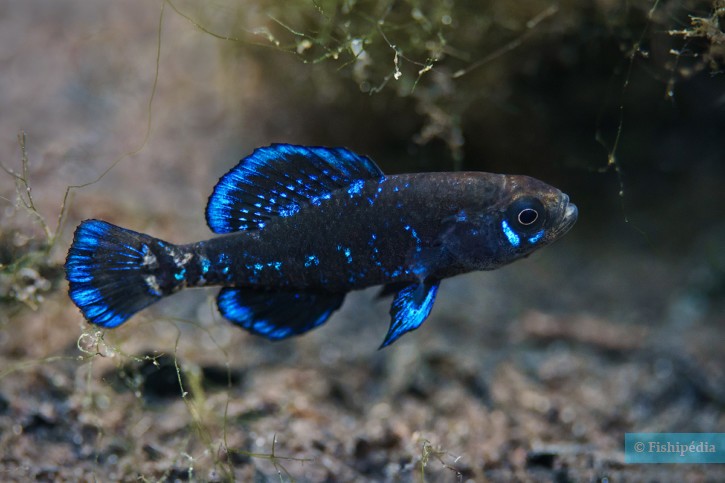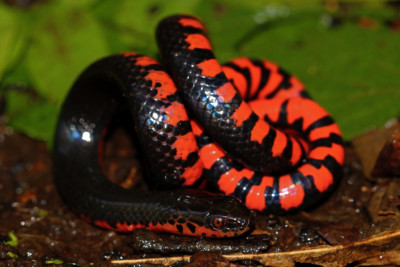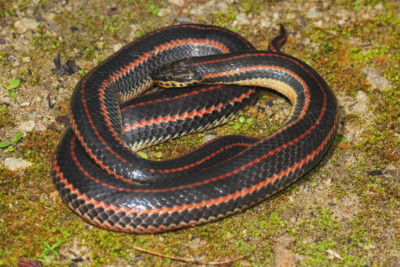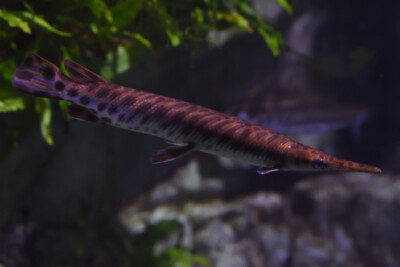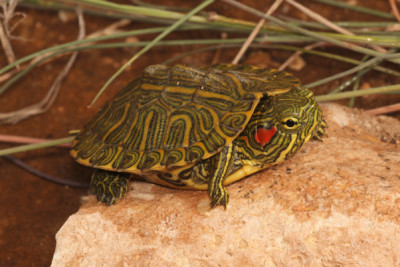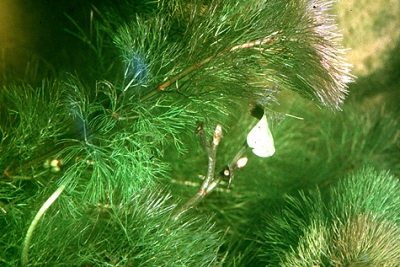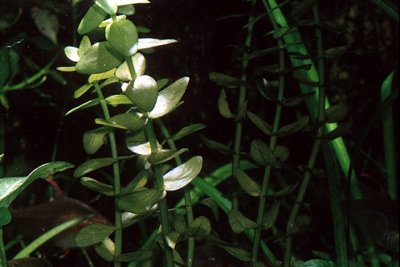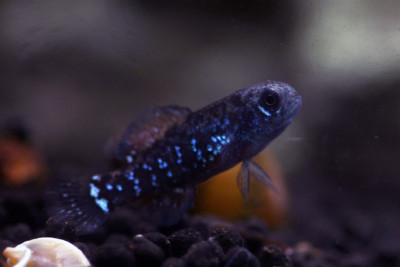gulf coast pygmy sunfish
| Scientific name | Elassoma gilberti |
|---|---|
| Descriptor | Snelson, Krabbenhoft & Quattro |
| Year of description | 2009 |
| IUCN category (World) | LC |
| Family | Elassomatidae |
| Genus | Elassoma |
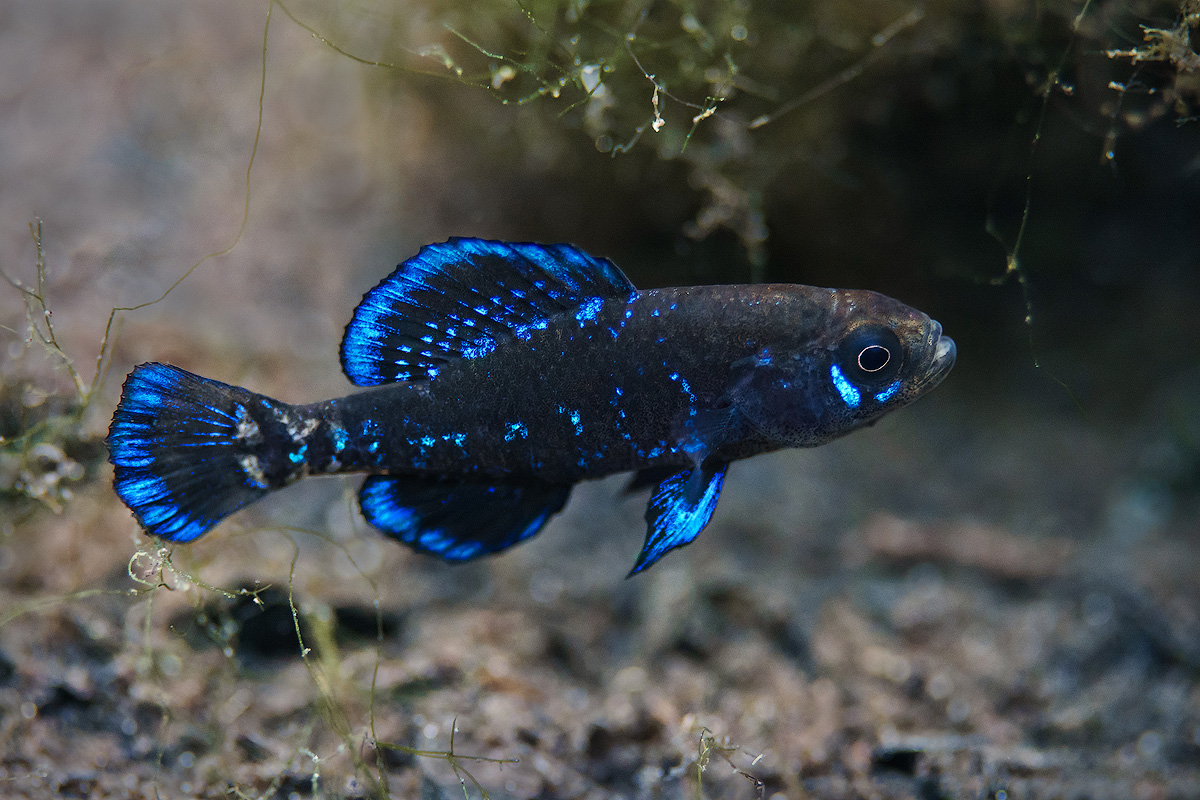

Introduction
The Gulf Coast Pygmy Sunfish is a micro-predator endemic to the northwest of Florida and the extreme south of Georgia. It has long been confused with E. okefenokee. Measuring less than 3 cm in adulthood, it is one of the smallest freshwater fish species in North America.
Who is it?
Morphology
-
Average size2 cm
-
Maximum size3 cm
-
Longevity8 year
-
Patternmottling
-
Average size2 cm
-
Maximum size3 cm
-
Longevity8 year
-
Patternmottling
How to recognize This fish ?
It is one of the smallest species in the genus. It can be distinguished from E. okefenokee by the four pores on the preopercular canal and seven rays on the anal fin. E. okefenokee has three pores and eight rays. The body of E. gilberti is also less deep and the fins are smaller.
Sexual dimorphism
The adult male is bigger than the female.
Behaviour & Life cycle
-
dietcarnivorous
-
Sociabilityliving in a group or alone
-
territorialYes
-
Way of livingdiurnal
Like their congeners, these sunfish hide in dark, densely planted areas. They behave as micro-predators, catching small prey that come near with their protractile mouths. Exclusively carnivorous, these fish feed on aquatic insects and larvae.
Males are territorial and may engage in skirmishes to protect a territory, especially during the breeding season.
Reproduction
-
Reproductionovipare qui dépose ses Œufs dans la végétation
This oviparous fish lays its eggs in vegetation. Males guard the nest. Reproduction may follow a seasonal cycle similar to that of E. evergladei.
Harmless species
This species does not represent any particular threats to humans when encountered in its natural environment.
Origin and distribution
Conservation status of populations (IUCN)
What is its habitat?
Natural environment characteristics
-
Temperature4 - 22 °C
-
pH (acidity)7 - 7.5
-
gh (hardness)8 - 12
-
FlowSlow and Stagnant
Biotope presentation
The species inhabits shallow depths in areas with a high presence of plants (aquatic and marsh plants, decomposing organic matter, branches...). It is found in various ecosystems, especially marshes and slow small streams. The ground is typically muddy or covered in humus.
Species of the same biotope
Main recommendations for fishkeeping
Deontology
In order to preserve wildlife, if you acquire this animal, it must not be released into the wild. See also, the Fishipedia charter.
Fishipedia supports the practice of responsible and environmentally friendly aquarium keeping. We encourage maintenance if it is motivated by a desire to understand the biological functioning of living things and if it is done with respect for animal life.
We believe that aquaristics is an opening to the discovery of aquatic environments, especially freshwater, and that this knowledge is necessary to better protect and respect these environments. Logically, we refute the compulsive purchase of animals that would not find a sufficient and / or adapted place in the host aquarium.
Our recommendationsThese tips apply to adult species from breeding. With regards to water conditions, wild species or close relatives must be kept under the same conditions as in their area of origin.
-
Min volume30 liters
-
Population min2
-
Temperature4 - 22 °C
-
pH (acidity)7 - 7.5
CharacteristicsThe characteristics below apply for adult species. They correspond to an average of cases, validated in maintenance condition.
-
Difficulty breedingThe farming difficulty is relative. It depends on experiments already carried out with similar species. First, it takes into consideration the robustness of the species, the ease of recreation of a favorable environment and the general behaviour with the other inhabitants of the aquarium.hard
-
Robustnesstolerant
-
Behaviourslightly aggressive
-
Availabilityunavailable
Recommended equipment from our partners
-
Aquarium
General reminders
It is strongly advised to read the complete dedicated file and to get information on the feedbacks of maintenance of the envisaged animal, this to avoid any potential conflict whose end result is generally the death of the individual (or the other inhabitants). It is important not to overload your aquarium to limit pollution. This will make maintenance easier.
In nature, animals are subject to weather conditions and live in waters with variable characteristics. The recommendations offered by our team for aquarium maintenance are a guidance and cannot be assimilated to scientific datas.
General reminder on maintenance datas
Le démarrage d'un aquarium est une partie primordiale pour l'équilibre et le bien-être des poissons. Lorsque l'on met en eau un aquarium, l'eau passe naturellement par un cycle biologique : le cycle de l'azote. Celui-ci dure environ trois semaines. Tous les 2 jours, nous vous conseillons de tester votre eau jusqu'à ce que le taux de nitrite soit à zéro pendant plusieurs jours d'affilée.
Pour accélérer ce cycle, vous pouvez utiliser un activateur de bactéries comme JBL Denitrol. Cette solution riche en bactéries vivantes et enzymes permet une mise en place rapide du cycle de l'azote. Les poissons peuvent alors être introduits plus rapidement.
Il est important de tester l'eau de son aquarium régulièrement pour maintenir un environnement sain pour les poissons et les autres habitants. Les tests d'eau permettent de mesurer les niveaux de différents paramètres tels que le pH, la dureté totale, ainsi que les taux de nitrates, de nitrites et d'ammoniaque.
Pour réaliser ces tests, vous pouvez utiliser des produits d'analyse spécialisés tels que JBL ProScan qui permet de réaliser un diagnostic de l'eau directement via un smartphone. Il existe également des coffrets de tests plus classiques de bandelettes, comme JBL PROAQUATEST.
En cas d’usage de l’eau du robinet, vous pouvez utiliser un conditionneur d’eau de type Biotopol de JBL pour éliminer les substances nocives comme le chlore, le cuivre, le plomb et le zinc. Les conditionneurs d'eau garantissent une meilleure santé aux poissons et une meilleure croissance des plantes.
Chlorine and chloramine are dangerous for the health of animals. Used to disinfect water, these agents are present in significant quantities in tap water. We recommend using an anti-chlorine agent every time you change the water. In addition to chlorine, treatments and medicines sold for aquarium use sometimes contain dangerous heavy metals in high doses.
Specific needs for the gulf coast pygmy sunfish
The gulf coast pygmy sunfish is a species which lives naturally at a temperature between 4 °C and 22 °C. For proper maintenance, the temperature should never exceed the 25°C for long periods. Nitrate levels should remain below 50mg/L. To keep the water clean and unpolluted, plan on changing 20% to 30% of the water volume each month.
The gulf coast pygmy sunfish is a species whose maintenance is rather reserved for informed aquarists . It can only be successfully carried out by carrying out a minimum of documentation work. Special husbandry conditions can easily lead to the death of the species.
Heating not required
As this species is used to living in fairly cool water, the presence of a resistance is not necessary in your aquarium. Also be careful to control the temperature of your tank in summer.Formal incompatibilities
Cohabitation & Environment
The gulf coast pygmy sunfish is a fish which it is advisable to maintain in specific aquarium. A 30 liter tank is sufficient to consider its breeding. Associating it with other species is not fundamentally impossible but a documentation work is necessary for the constitution of the population.
It should be noticed that this species should not be kept with large crustaceans or fish, as it would become a prey of choice. Smaller species should preferably be inserted in the aquarium some time before the larger ones. Moreover, if you want to breed it, it is better to put them in a specific aquarium.The species enjoys a particularly vegetation-rich environment. The addition of plants will provide many useful hiding places for resting. These areas are also conducive to possible breeding in the aquarium. Floating plants such as Salvinia can be added to recreate the subdued atmosphere characteristic of its living conditions in the wild.
Tips for feeding
The gulf coast pygmy sunfish is carnivorous.
This species can eat dry food (flakes, pellets), fresh food and frozen food. To avoid deficiencies, it is recommended to vary the types of food.
You should not overfeed your residents to avoid polluting the water. For most species, it is better to feed a few small portions each day rather than one large meal.
Food recommendations from our partner JBL - Products PRONOVO
-
Granules
-
Flakes
-
Sticks
Reproduction protocol
-
egg-laying protectionNo
Hybridization risks
In general, it is advised not to mix several species of the same genus or different varieties of the same species, to avoid the risks of hybridization.
These plants might interest you
Plants play a crucial role in aquariums, both for their ability to filter water by absorbing excess nutrients and for their aesthetic contribution. They provide fish with natural hiding places, can serve as breeding sites, and generally help maintain the overall balance and optimal conditions of the aquarium. The selection presented here includes species from the same regions as the species described on this page, although they do not necessarily come from its exact natural biotope.
To go further
Sources & Contributions
Participation & Validation
The Fishipedia team and specialist contributors are committed to providing high-quality content. However, although the information comes from scientific sources or testimonials from specialists, the cards may contain inaccuracies.

Benoit Chartrer
Translation
Translation done with the valuable contribution of our translators, who make this information available to a wider audience. We sincerely thank them for their commitment.
Bibliographic references
The Behavior of the Pumpkinseed Sunfish, Lepomis Gibbosus (Linneaus), With Notes On the Behavior of Other Species of Lepomis and the Pigmy Sunfish, Elassoma Evergladei - Helen Carter Miller - - 1963.
Culture protocols for the gulf coast pygmy sunfish, Elassoma gilberti - Taylor N. Lipscomb - Quenton M. Tuckett - Amy L. Wood - Joshua T. Patterson - Shane W. Ramee - Craig A. Watson - Matthew A. DiMaggio - Journal of the World Aquaculture Society - 2019.
Scientific partners
Same genus
Species of the same biotope
